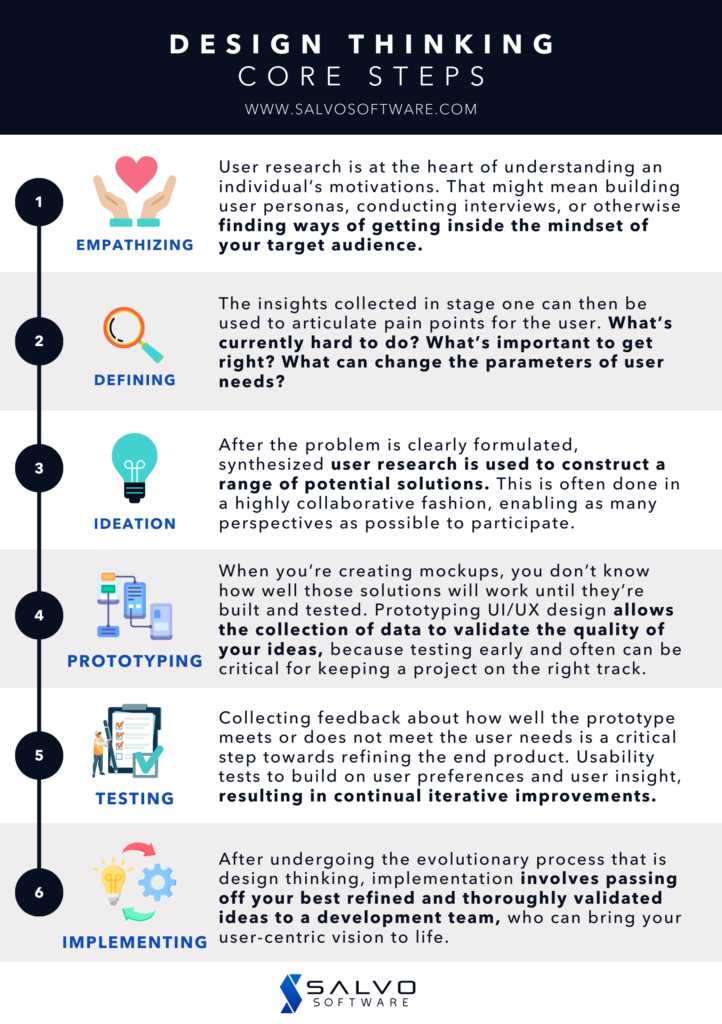Crafting Exceptional Experiences: Harnessing Design Thinking for UI/UX Problem Solving
Everyone has experienced bad UI/UX. That’s when avoidable mistakes happen, frustration occurs, and people start looking for ways to avoid repeated interactions. But every bad UI/UX design may have looked great on paper. It’s only when theory becomes practice that flaws become apparent — which can make it easy to build the wrong things.
Design thinking is a powerful technique for solving those kinds of counter-intuitive design problems. By infusing testing methodology with scientifically validated empathy, UI/UX development can be guided along a process of continual improvement that produces truly innovative user-friendly interfaces.
But it all starts with a UI/UX design company that has experience enhancing user experience through design thinking.

UI UX Design in Practice
When people have a wealth of options to sort, they’re at greater risk of suffering from decision fatigue. During its early years, Airbnb was no exception. Around the same time that it exploded in popularity, Airbnb’s users were overwhelmed by choice during booking. And that created a variety of challenges to engagement.
The solution seems simple – make the booking process more intuitive to navigate. But what’s intuitive, and how do you know it when you see it? That’s where design thinking comes into play. Because in the right hands, enhancing user experience through design thinking is like a science.
It all began with a better understanding of the user. By learning more about their pain points and motivations for booking travel accommodations, preferences were learned, customer personas were defined, and weaknesses in the booking process were clearly identified.
Leveraging all of that scientifically validated user feedback, filtering options were improved, new features to personalize recommendations were added, and opportunities for decision fatigue were broken down. The UI/UX design results speak for themselves: user satisfaction and engagement skyrocketed as people found it easier to book accommodations.

UI UX Design FAQs
What is Design Thinking, and how does it apply to UI/UX design?
Design Thinking is a method of solving design problems. It’s based on understanding the end-user and then using that knowledge as the foundation for serving the unique needs of equally unique individuals. By making all stages of development more user-oriented, from ideation to testing, you can find more creative solutions and incrementally improve on them.
Human-centric UI/UX design is about moving past the more obvious solutions to design problems, and instead finding the best possible solutions. Since different people interact with user interfaces in different ways, enhancing user experience through design thinking is frequently the most effective means of developing the highest-performing user experience.
How does empathy play a role in the Design Thinking process for UI/UX?
Empathy is about putting yourself in another person’s shoes — and that’s the core of user-centered design thinking. The industrial welder who’s pawing at an app through a thick pair of protective equipment isn’t going to have the same experience as an elderly woman interacting with the display on her vehicle’s dashboard. But to understand the perspectives of people who have different experiences than yourself, you need more than a vivid imagination.
When an experienced UI/UX designer is able to understand the experiences of the end-user, the results are typically better than what any developer could achieve in the isolation of their own environment. Because when you empathize with the needs, behaviors, and pain points of the people using the UI/UX, the results will always resonate better with their intended audience.

What are the key stages of Design Thinking, and how are they applied in UI/UX design?
A person’s needs are rarely entirely obvious. This is why the key stages of design thinking can be used to guide an experienced UI/UX design company through uncovering what those needs are — as well as new and innovative ways to meet them.

Of course, these steps aren’t always linear. For example, successful ideation and prototyping in UX design can lead developers to retrace their steps, redefine the problems they’re trying to solve, and then rework development with an improved understanding of what to do next.
How does Design Thinking contribute to creating user interfaces that resonate with their target audience?
When your project has an ambiguous goal, like “improving engagement”, you’ll want a problem-solving approach in design that prioritizes user feedback. Because the most robust innovation in UI/UX design will almost always originate from an understanding of what the user needs.
Along with iterative improvement guided by continual user feedback, the result of design thinking in UI/UX is an experience that’s been uniquely tailored to the needs of the individual. In short — people like things that work. And design thinking creates user interfaces that work.
Can Design Thinking be integrated into an existing UI/UX design process?
With an experienced UI/UX designer, user-centered design thinking can be integrated into existing workflows. Enhancing the user experience through design thinking requires an experienced hand to see every avenue of development opportunity.
For example, you can use design thinking to rethink UI/UX design problems, ensuring they’re framed with the user’s perspective in mind. You can encourage collaboration between different teams, like marketing and development, to incorporate as many perspectives as possible during ideation. You can start producing rapid new iterations of prototypes to test early and often, or you can conduct user interviews to infuse empathy into the design process.
Many of these principles can be integrated into existing UI/UX processes at virtually any stage of development.

Crafting Exceptional Experiences: Harnessing Design Thinking for UI/UX Problem Solving highlights the importance of design thinking in enhancing UI/UX. This approach is crucial for turning theoretical designs into practical, user-friendly interfaces. It involves understanding user needs, empathizing with their experiences, and continuously improving the design. An example is Airbnb, which used design thinking to simplify its booking process, leading to increased user satisfaction. The process encompasses empathizing, defining, ideating, prototyping, testing, and implementing, and can be integrated into existing UI/UX workflows to create interfaces that resonate well with users.


 The Ultimate Guide to Business Automation: What is It, Why is it Important, How Does it Work?
The Ultimate Guide to Business Automation: What is It, Why is it Important, How Does it Work?  Internet of Things (IoT): A Beginner’s Guide
Internet of Things (IoT): A Beginner’s Guide  ERP Systems: Everything You Need to Know
ERP Systems: Everything You Need to Know  Unlocking Knowledge: Navigating the Future of Education with AI in Learning Applications
Unlocking Knowledge: Navigating the Future of Education with AI in Learning Applications  Crafting Exceptional Experiences: Harnessing Design Thinking for UI/UX Problem Solving
Crafting Exceptional Experiences: Harnessing Design Thinking for UI/UX Problem Solving